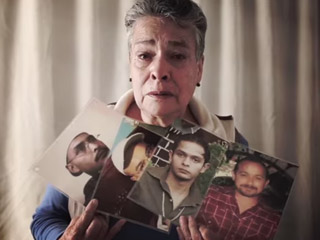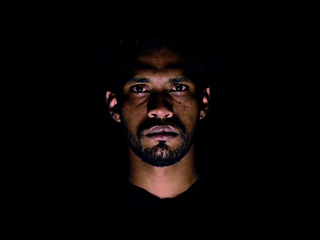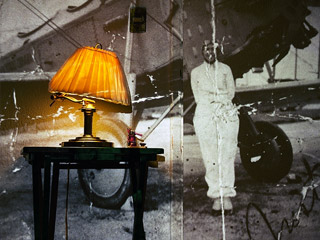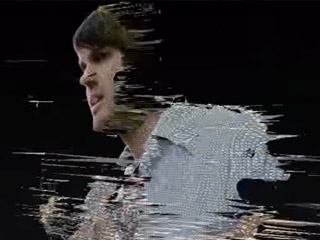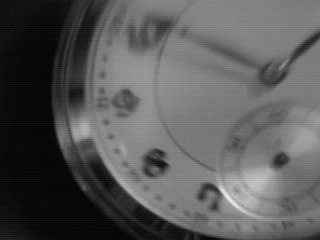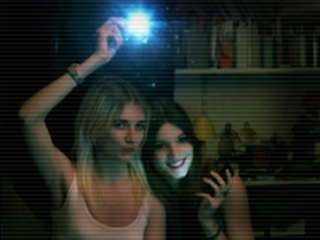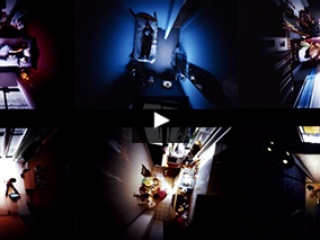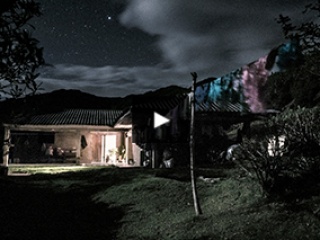Yang Yongliang





Artificial Wonderland is a series started in 2010. Yang Yongliang uses images of architecture as brushstrokes; heavy mountain rocks with enriched details draw a faithful reference to Song Dynasty landscape painting. Urban development makes life in the city flourish, but it also imprisons these lives; centuries-old cultural tradition in China is profound, but it has also remained stagnant. Ancient Chinese people painted landscapes to praise the greatness of nature; Yang's works, on the other hand, lead towards a critical re-thinking of contemporary reality.

















In Artificial Wonderland II (2014), there are digital replicas of two Song Dynasty master paintings, namely Travelers Among Mountains and Steams (Fan Kuan) and Wintery Forest in the Snow (anonymous). Whereas ancient landscapes are often seen as being without time, Yang's interpretation of the latter work is a nocturnal image, titled Wintery Forest in the Night. The 2014 series marks a step forward in terms of digital technique--the piece is larger than ever and enriched with tremendous detail images. Also, Yang conjucted natural mountain rocks into the signature artificial landscape for the first time. Images of the mountain rocks are mostly taken in Iceland and Norway. In 2015, Artificial Wonderland II was shortlisted in the Prix Pictet – the global award in photography and sustainability.
The Day of Perpetual Night and The Night of Perpetual Day, are two pieces that exemplify a line of recent video work by Yang Yongliang. In them, the traditional landscape extends a narrative between a subtle temporality and diffuse timelessness. With the same rigorous technique that characterizes his still images, in these videos he uses time as a tool to emphasize the paradox of our time: the crossroads between necessary nostalgia, our daily chaos and imagination.

The Night of Perpetual Day. Artwork preview here

The Day of Perpetual Night. Artwork preview here
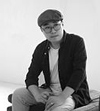 Yang Yongliang (Shanghai, 1980). He graduated from China Academy of Art in 2003, majored in visual communication. He started his experiments with contemporary art in 2005, and his practice involved varied media including photography, painting, video and installation. Yang exploits a connection between traditional art and the contemporary, implementing ancient oriental aesthetics and literati beliefs with modern language and digital techniques. His work as an expanding meta-narrative that draws from history, myth and social culture, and plays out in the context of the city and its ever-changing landscapes.
Yang Yongliang (Shanghai, 1980). He graduated from China Academy of Art in 2003, majored in visual communication. He started his experiments with contemporary art in 2005, and his practice involved varied media including photography, painting, video and installation. Yang exploits a connection between traditional art and the contemporary, implementing ancient oriental aesthetics and literati beliefs with modern language and digital techniques. His work as an expanding meta-narrative that draws from history, myth and social culture, and plays out in the context of the city and its ever-changing landscapes.




Artificial Wonderland is a series started in 2010. Yang Yongliang uses images of architecture as brushstrokes; heavy mountain rocks with enriched details draw a faithful reference to Song Dynasty landscape painting. Urban development makes life in the city flourish, but it also imprisons these lives; centuries-old cultural tradition in China is profound, but it has also remained stagnant. Ancient Chinese people painted landscapes to praise the greatness of nature; Yang's works, on the other hand, lead towards a critical re-thinking of contemporary reality.

















In Artificial Wonderland II (2014), there are digital replicas of two Song Dynasty master paintings, namely Travelers Among Mountains and Steams (Fan Kuan) and Wintery Forest in the Snow (anonymous). Whereas ancient landscapes are often seen as being without time, Yang's interpretation of the latter work is a nocturnal image, titled Wintery Forest in the Night. The 2014 series marks a step forward in terms of digital technique--the piece is larger than ever and enriched with tremendous detail images. Also, Yang conjucted natural mountain rocks into the signature artificial landscape for the first time. Images of the mountain rocks are mostly taken in Iceland and Norway. In 2015, Artificial Wonderland II was shortlisted in the Prix Pictet – the global award in photography and sustainability.
The Day of Perpetual Night and The Night of Perpetual Day, are two pieces that exemplify a line of recent video work by Yang Yongliang. In them, the traditional landscape extends a narrative between a subtle temporality and diffuse timelessness. With the same rigorous technique that characterizes his still images, in these videos he uses time as a tool to emphasize the paradox of our time: the crossroads between necessary nostalgia, our daily chaos and imagination.

The Night of Perpetual Day. Artwork preview here

The Day of Perpetual Night. Artwork preview here
 Yang Yongliang (Shanghai, 1980). He graduated from China Academy of Art in 2003, majored in visual communication. He started his experiments with contemporary art in 2005, and his practice involved varied media including photography, painting, video and installation. Yang exploits a connection between traditional art and the contemporary, implementing ancient oriental aesthetics and literati beliefs with modern language and digital techniques. His work as an expanding meta-narrative that draws from history, myth and social culture, and plays out in the context of the city and its ever-changing landscapes.
Yang Yongliang (Shanghai, 1980). He graduated from China Academy of Art in 2003, majored in visual communication. He started his experiments with contemporary art in 2005, and his practice involved varied media including photography, painting, video and installation. Yang exploits a connection between traditional art and the contemporary, implementing ancient oriental aesthetics and literati beliefs with modern language and digital techniques. His work as an expanding meta-narrative that draws from history, myth and social culture, and plays out in the context of the city and its ever-changing landscapes.Lei Lei + Thomas Sauvin
Beijing Silvermine is a project by french photographer Thomas Sauvin to recover the photographic records of the people of Beijing after the Cultural Revolution, from 1985 when photography (mainly 35 mm) became popular in China, until about 2005, when it began to give way to digital photography.
For several years, Sauvin collected negatives (many of them never printed), recovered from a recycling plant on the outskirts of Beijing. After an exhaustive selection and digitization, he has created a fascinating archive with over half a million 35 mm negatives that has become an intriguing record of the public and private lives of the inhabitants of that city. Over the past 20 years, China has experienced unprecedented economic liberalization, which has completely redefined the way people in its cities thrive, travel, eat and enjoy themselves.
This collection of material from anonymous sources has served as the input for editing a collection of photo books and exhibitions, in which Sauvin provides an authorial contribution to the reinterpretation of a form of appropriation, which has even been the starting point for collaborative pieces such as the animation by chinese visual artist Lei Lei, who selected 3,000 of these images to create an audiovisual piece entitled precisely Recycled in 2013. Director Emiliad Guillermine produced a short documentary that bears witness to Sauvin’s experience and his meticulous collection, sorting, editing and digitization of the thousands of images he recovered.
Thus, Sauvin’s work brings us closer to part of the collective memory of current Chinese society, enabling us to understand how it has changed its cultural dynamics in recent years, while providing a new perspective on the experience of the visual appropriation and recycling at a time when the mass production and consumption of images leads us to understand the importance, but above all the enormous authorial possibilities of the editor and curator to generate new discourses.
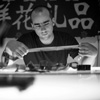 Thomas Sauvin (Francia) A photography collector and editor who lives in Beijing. Since 2006 he exclusively works as a consultant for the UK-based Archive of Modern Conflict, an independent archive and publisher, for whom he collects Chinese works, from contemporary photography to period publications to anonymous photography. Sauvin has had exhibitions of his work, and published through Archive of Modern Conflict.
Thomas Sauvin (Francia) A photography collector and editor who lives in Beijing. Since 2006 he exclusively works as a consultant for the UK-based Archive of Modern Conflict, an independent archive and publisher, for whom he collects Chinese works, from contemporary photography to period publications to anonymous photography. Sauvin has had exhibitions of his work, and published through Archive of Modern Conflict.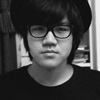 Lei Lei (China) An up-and-coming multimedia Chinese animation artist with his hands on graphic design, illustration, short cartoon, graffiti and music also. In 2009 he got a master's degree from Tsinghua University. In 2010, his film This is LOVE was shown at Ottawa International Animation Festival and awarded The 2010 Best Narrative Short. In 2013 his film Recycled was selected by Annecy festival and was the Winner Grand Prix shorts - non-narrative at Holland International Animation Film Festival. In 2014 he is the Jury of Zagreb / Holland International Animation Film Festival. and he was the winner of 2014 asian cultural council grant.
Lei Lei (China) An up-and-coming multimedia Chinese animation artist with his hands on graphic design, illustration, short cartoon, graffiti and music also. In 2009 he got a master's degree from Tsinghua University. In 2010, his film This is LOVE was shown at Ottawa International Animation Festival and awarded The 2010 Best Narrative Short. In 2013 his film Recycled was selected by Annecy festival and was the Winner Grand Prix shorts - non-narrative at Holland International Animation Film Festival. In 2014 he is the Jury of Zagreb / Holland International Animation Film Festival. and he was the winner of 2014 asian cultural council grant.Beijing Silvermine is a project by french photographer Thomas Sauvin to recover the photographic records of the people of Beijing after the Cultural Revolution, from 1985 when photography (mainly 35 mm) became popular in China, until about 2005, when it began to give way to digital photography.
For several years, Sauvin collected negatives (many of them never printed), recovered from a recycling plant on the outskirts of Beijing. After an exhaustive selection and digitization, he has created a fascinating archive with over half a million 35 mm negatives that has become an intriguing record of the public and private lives of the inhabitants of that city. Over the past 20 years, China has experienced unprecedented economic liberalization, which has completely redefined the way people in its cities thrive, travel, eat and enjoy themselves.
This collection of material from anonymous sources has served as the input for editing a collection of photo books and exhibitions, in which Sauvin provides an authorial contribution to the reinterpretation of a form of appropriation, which has even been the starting point for collaborative pieces such as the animation by chinese visual artist Lei Lei, who selected 3,000 of these images to create an audiovisual piece entitled precisely Recycled in 2013. Director Emiliad Guillermine produced a short documentary that bears witness to Sauvin’s experience and his meticulous collection, sorting, editing and digitization of the thousands of images he recovered.
Thus, Sauvin’s work brings us closer to part of the collective memory of current Chinese society, enabling us to understand how it has changed its cultural dynamics in recent years, while providing a new perspective on the experience of the visual appropriation and recycling at a time when the mass production and consumption of images leads us to understand the importance, but above all the enormous authorial possibilities of the editor and curator to generate new discourses.
 Thomas Sauvin (Francia) A photography collector and editor who lives in Beijing. Since 2006 he exclusively works as a consultant for the UK-based Archive of Modern Conflict, an independent archive and publisher, for whom he collects Chinese works, from contemporary photography to period publications to anonymous photography. Sauvin has had exhibitions of his work, and published through Archive of Modern Conflict.
Thomas Sauvin (Francia) A photography collector and editor who lives in Beijing. Since 2006 he exclusively works as a consultant for the UK-based Archive of Modern Conflict, an independent archive and publisher, for whom he collects Chinese works, from contemporary photography to period publications to anonymous photography. Sauvin has had exhibitions of his work, and published through Archive of Modern Conflict. Lei Lei (China) An up-and-coming multimedia Chinese animation artist with his hands on graphic design, illustration, short cartoon, graffiti and music also. In 2009 he got a master's degree from Tsinghua University. In 2010, his film This is LOVE was shown at Ottawa International Animation Festival and awarded The 2010 Best Narrative Short. In 2013 his film Recycled was selected by Annecy festival and was the Winner Grand Prix shorts - non-narrative at Holland International Animation Film Festival. In 2014 he is the Jury of Zagreb / Holland International Animation Film Festival. and he was the winner of 2014 asian cultural council grant.
Lei Lei (China) An up-and-coming multimedia Chinese animation artist with his hands on graphic design, illustration, short cartoon, graffiti and music also. In 2009 he got a master's degree from Tsinghua University. In 2010, his film This is LOVE was shown at Ottawa International Animation Festival and awarded The 2010 Best Narrative Short. In 2013 his film Recycled was selected by Annecy festival and was the Winner Grand Prix shorts - non-narrative at Holland International Animation Film Festival. In 2014 he is the Jury of Zagreb / Holland International Animation Film Festival. and he was the winner of 2014 asian cultural council grant.Alfredo Esparza
450 videoportraits made with cell phone
Since people daily have to travel long distances in Mexico City to get from home to work or school and then coming back, subway users employ this medium as a temporary extension of their homes, where they can claim as much privacy and intimacy they need; even when the metro is overcrowded.
Just to win a few minutes a day, travellers keep their minds off from what happens in the carriage during the trip by chatting with their companion, finishing pending work, resting, or having a moment of introspection.
What really matters is that the journey enables travellers to do more than simply move from one place to another, not only by the urge of snatching time in a city where traveling takes so long, but also to take the opportunity to spare some time for oneself.
| videoportrait #32 | videoportrait #41 | videoportrait #56 |
| videoportrait #123 | videoportrait #197 | videoportrait #201 |
| videoportrait #222 | videoportrait #262 | videoportrait #297 |
| videoportrait #360 | videoportrait #363 | videoportrait #375 |
| videoportrait #395 | videoportrait #412 | videoportrait #343 |
| videoportrait #356 | videoportrait #272 | videoportrait #323 |
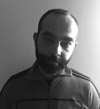 Alfredo Esparza (Torreon, Mexico. 1980) Visual artist. Uses photography and video as main tools to produce his pieces. He had solo exhibitions in Torreon and Mexico City, and many group shows In US, Italy, Spain and Mexico. Most of his work deals with the tension generated by the interaction between strangers in public or private spaces. His work has been published in magazines such as Vice, Cuartoscuro and Xoo. From 2012 to 2014 he worked as head of exhibitions and resident curator and museographer at the Museo Nacional de Culturas Populares, in Mexico City. He also produced independent exhibitions for both private and public institutions in Mexico City. Since 2012, he is associated curator at .357 Gallery, in Mexico City. Lives and works between Torreon and Mexico City.
Alfredo Esparza (Torreon, Mexico. 1980) Visual artist. Uses photography and video as main tools to produce his pieces. He had solo exhibitions in Torreon and Mexico City, and many group shows In US, Italy, Spain and Mexico. Most of his work deals with the tension generated by the interaction between strangers in public or private spaces. His work has been published in magazines such as Vice, Cuartoscuro and Xoo. From 2012 to 2014 he worked as head of exhibitions and resident curator and museographer at the Museo Nacional de Culturas Populares, in Mexico City. He also produced independent exhibitions for both private and public institutions in Mexico City. Since 2012, he is associated curator at .357 Gallery, in Mexico City. Lives and works between Torreon and Mexico City.450 videoportraits made with cell phone
Since people daily have to travel long distances in Mexico City to get from home to work or school and then coming back, subway users employ this medium as a temporary extension of their homes, where they can claim as much privacy and intimacy they need; even when the metro is overcrowded.
Just to win a few minutes a day, travellers keep their minds off from what happens in the carriage during the trip by chatting with their companion, finishing pending work, resting, or having a moment of introspection.
What really matters is that the journey enables travellers to do more than simply move from one place to another, not only by the urge of snatching time in a city where traveling takes so long, but also to take the opportunity to spare some time for oneself.
| videoportrait #32 | videoportrait #41 | videoportrait #56 |
| videoportrait #123 | videoportrait #197 | videoportrait #201 |
| videoportrait #222 | videoportrait #262 | videoportrait #297 |
| videoportrait #360 | videoportrait #363 | videoportrait #375 |
| videoportrait #395 | videoportrait #412 | videoportrait #343 |
| videoportrait #356 | videoportrait #272 | videoportrait #323 |
 Alfredo Esparza (Torreon, Mexico. 1980) Visual artist. Uses photography and video as main tools to produce his pieces. He had solo exhibitions in Torreon and Mexico City, and many group shows In US, Italy, Spain and Mexico. Most of his work deals with the tension generated by the interaction between strangers in public or private spaces. His work has been published in magazines such as Vice, Cuartoscuro and Xoo. From 2012 to 2014 he worked as head of exhibitions and resident curator and museographer at the Museo Nacional de Culturas Populares, in Mexico City. He also produced independent exhibitions for both private and public institutions in Mexico City. Since 2012, he is associated curator at .357 Gallery, in Mexico City. Lives and works between Torreon and Mexico City.
Alfredo Esparza (Torreon, Mexico. 1980) Visual artist. Uses photography and video as main tools to produce his pieces. He had solo exhibitions in Torreon and Mexico City, and many group shows In US, Italy, Spain and Mexico. Most of his work deals with the tension generated by the interaction between strangers in public or private spaces. His work has been published in magazines such as Vice, Cuartoscuro and Xoo. From 2012 to 2014 he worked as head of exhibitions and resident curator and museographer at the Museo Nacional de Culturas Populares, in Mexico City. He also produced independent exhibitions for both private and public institutions in Mexico City. Since 2012, he is associated curator at .357 Gallery, in Mexico City. Lives and works between Torreon and Mexico City.Sammy Slabbinck
Sammy Slabbinck is a Belgian artist who appropriates photographic elements and reinterprets them to create his collages. In this sense, Sammy is a collector of images who tries to create a timeless atmosphere by combining photography and illustrations of different times and from very diverse sources, to create narratives with a touch of irony and criticism.
In comparison with other similar works, the composition and concepts of Sammy’s images are very precise. He leaves nothing to chance or free interpretation. His pieces are not only based on aesthetic decisions, for which this technique is often dismissed as artistic experimentation, but he goes further and uses the technological possibilities to take the work to another level. Using stop motion, he generates short animations that contain a particular narrative, using playful and metaphorical resources, and like this he refreshes the traditional collage and offers new possibilities.
In this way, this technique is no longer a purely graphic resource and is fully incorporated into the audiovisual language; thereby achieving an interesting convergence of formats and languages that definitely perpetuate the relevance of the collage as one of the techniques that has accompanied photography from its beginnings.
| Baby eruptions | Printing galaxies | On the origin of sewing species |
| Dissection Town | Shooting birds | The eternal chase |
| David is bored | Playtime | Being a stock photography guy is hard work... |
|
Was I some kind of nut? It worried her that she couldn't get a charge out of things like others did... |
Shooting breakfast | The Byrds |
| Roman selfie | The Monday blues | Image not found |
| Broken face | . | What came first? The paper chicken or the egg? |
| Ready for lift off | Kanye: happy vs sad | Evolution |
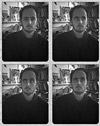 Sammy Slabbinick (Belgium, 1977). Artist tha combines a range of found photographs creating surreal collages on paper & prints and stop motion animations.
Sammy Slabbinick (Belgium, 1977). Artist tha combines a range of found photographs creating surreal collages on paper & prints and stop motion animations.Sammy Slabbinck is a Belgian artist who appropriates photographic elements and reinterprets them to create his collages. In this sense, Sammy is a collector of images who tries to create a timeless atmosphere by combining photography and illustrations of different times and from very diverse sources, to create narratives with a touch of irony and criticism.
In comparison with other similar works, the composition and concepts of Sammy’s images are very precise. He leaves nothing to chance or free interpretation. His pieces are not only based on aesthetic decisions, for which this technique is often dismissed as artistic experimentation, but he goes further and uses the technological possibilities to take the work to another level. Using stop motion, he generates short animations that contain a particular narrative, using playful and metaphorical resources, and like this he refreshes the traditional collage and offers new possibilities.
In this way, this technique is no longer a purely graphic resource and is fully incorporated into the audiovisual language; thereby achieving an interesting convergence of formats and languages that definitely perpetuate the relevance of the collage as one of the techniques that has accompanied photography from its beginnings.
| Baby eruptions | Printing galaxies | On the origin of sewing species |
| Dissection Town | Shooting birds | The eternal chase |
| David is bored | Playtime | Being a stock photography guy is hard work... |
|
Was I some kind of nut? It worried her that she couldn't get a charge out of things like others did... |
Shooting breakfast | The Byrds |
| Roman selfie | The Monday blues | Image not found |
| Broken face | . | What came first? The paper chicken or the egg? |
| Ready for lift off | Kanye: happy vs sad | Evolution |
 Sammy Slabbinick (Belgium, 1977). Artist tha combines a range of found photographs creating surreal collages on paper & prints and stop motion animations.
Sammy Slabbinick (Belgium, 1977). Artist tha combines a range of found photographs creating surreal collages on paper & prints and stop motion animations.ZoneZero
Geography of Pain is meant to be a virtual geographical space where the user or visitor can take a tour through different regions of Mexico and can listen to various stories about the events that overwhelmed not only the institutional and political system but also the authorities and the citizens of this country; stories about people who lost their lives, people who went missing.
This web documentary exists thanks to the convergence of documentary film with the interactivity that the new digital media offers. Audiovisual language was mixed with programming language and resulted in new interactive ways of storytelling, namely, the interactive documentary. In this way, this project uses a clear and a direct narrative that allows the viewer to understand the experience of insecurity in Mexico and the cases of missing persons.
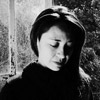 Mónica González. Photographer. She studied in UNAM (Universidad Nacional Autónoma de México) at the Political and Sociological Sciences Faculty, the major in Communication Sciences and Journalism. She has worked for the Expansión Magazine, The Dallas Morning News, Newsweek Magazine, Nike, HBO Project 48, NOTIMEX, El Economista newspaper, El Centro journal, VICE Mexico, NFB Canada and currently working as a photographer for the Milenio journal. She won the student grant Jóvenes Creativos (Creative Youth) 2009-2010 given by FONCA CONACULTA due to her project El sentido anatómico (The Anatomic Sense), transsexuality, the new nuclear family. She received the National Journalism Award in 2006 under the category of Photography due to her Migration Coverage of Mexicans in the border of Altar – Sasabe, Sonora, through Arizona’s desert. And in 2011 for her documentary work Geografía del Dolor (Geography of Pain)
Mónica González. Photographer. She studied in UNAM (Universidad Nacional Autónoma de México) at the Political and Sociological Sciences Faculty, the major in Communication Sciences and Journalism. She has worked for the Expansión Magazine, The Dallas Morning News, Newsweek Magazine, Nike, HBO Project 48, NOTIMEX, El Economista newspaper, El Centro journal, VICE Mexico, NFB Canada and currently working as a photographer for the Milenio journal. She won the student grant Jóvenes Creativos (Creative Youth) 2009-2010 given by FONCA CONACULTA due to her project El sentido anatómico (The Anatomic Sense), transsexuality, the new nuclear family. She received the National Journalism Award in 2006 under the category of Photography due to her Migration Coverage of Mexicans in the border of Altar – Sasabe, Sonora, through Arizona’s desert. And in 2011 for her documentary work Geografía del Dolor (Geography of Pain)Geography of Pain is meant to be a virtual geographical space where the user or visitor can take a tour through different regions of Mexico and can listen to various stories about the events that overwhelmed not only the institutional and political system but also the authorities and the citizens of this country; stories about people who lost their lives, people who went missing.
This web documentary exists thanks to the convergence of documentary film with the interactivity that the new digital media offers. Audiovisual language was mixed with programming language and resulted in new interactive ways of storytelling, namely, the interactive documentary. In this way, this project uses a clear and a direct narrative that allows the viewer to understand the experience of insecurity in Mexico and the cases of missing persons.
 Mónica González. Photographer. She studied in UNAM (Universidad Nacional Autónoma de México) at the Political and Sociological Sciences Faculty, the major in Communication Sciences and Journalism. She has worked for the Expansión Magazine, The Dallas Morning News, Newsweek Magazine, Nike, HBO Project 48, NOTIMEX, El Economista newspaper, El Centro journal, VICE Mexico, NFB Canada and currently working as a photographer for the Milenio journal. She won the student grant Jóvenes Creativos (Creative Youth) 2009-2010 given by FONCA CONACULTA due to her project El sentido anatómico (The Anatomic Sense), transsexuality, the new nuclear family. She received the National Journalism Award in 2006 under the category of Photography due to her Migration Coverage of Mexicans in the border of Altar – Sasabe, Sonora, through Arizona’s desert. And in 2011 for her documentary work Geografía del Dolor (Geography of Pain)
Mónica González. Photographer. She studied in UNAM (Universidad Nacional Autónoma de México) at the Political and Sociological Sciences Faculty, the major in Communication Sciences and Journalism. She has worked for the Expansión Magazine, The Dallas Morning News, Newsweek Magazine, Nike, HBO Project 48, NOTIMEX, El Economista newspaper, El Centro journal, VICE Mexico, NFB Canada and currently working as a photographer for the Milenio journal. She won the student grant Jóvenes Creativos (Creative Youth) 2009-2010 given by FONCA CONACULTA due to her project El sentido anatómico (The Anatomic Sense), transsexuality, the new nuclear family. She received the National Journalism Award in 2006 under the category of Photography due to her Migration Coverage of Mexicans in the border of Altar – Sasabe, Sonora, through Arizona’s desert. And in 2011 for her documentary work Geografía del Dolor (Geography of Pain)Antonio Briceño
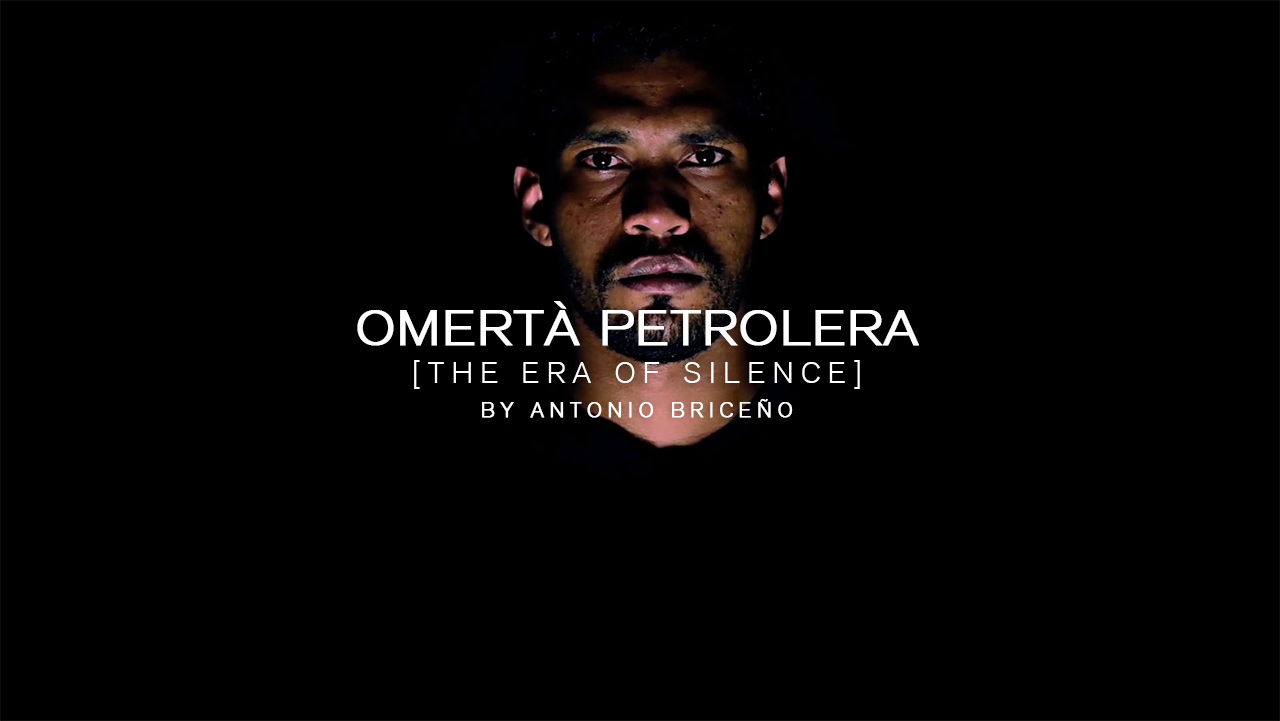
There is nothing scarier than silence. A stony, cheerless, impenetrable silence to reality. A silence that does not dare to be broken; I saw, but better not. Silence from fear, silence from indifference, silence from interest, silence from complicity. The silence of you first, then me. Silence which is degrading, repulsive, abject. Shame for the species.
A glacial era freezing screams. Judges, partners in crime, the argumentative, the dogmatic, the evasive, the media (who remain). Governments, nations, continental and global authorities. All frozen. There is too much oil here for them to be heard; too much money for them to listen. The thunderous cries of their fellow man has still not reached them. The pain of the abused does not affect them. Humiliation does not make them blush, even when it is perpetrated in the spotlight. General omertà, while they give you their barrels. The petroleum era of silence. Shame for history.
April 2014
Fragment Video 1 Video installation. Color. Duration and measured variables
Fragment Video 2 Video instalación. Color. Duration and measured variables
Fragment Video 3 Video installation. Color. Duration and measured variables.
Fragment Video 4 VVideo installation. Color. Duration and measured variables.
Fragment Video 5 Video installation. Color. Duration and measured variables.
Fragment Video 6 Video installation. Color. Duration and measured variables.
Fragment Video 7 Video installation. Color. Duration and measured variables.
Fragment Video 8 Video installation. Color. Duration and measured variables.
Fragment Video 9 Video installation. Color. Duration and measured variables.
Fragment Video 10 Video installation. Color. Duration and measured variables.
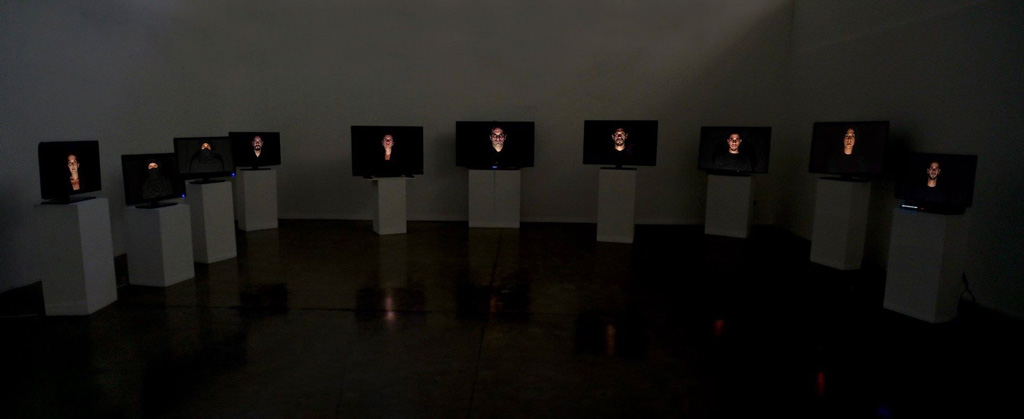
 Antonio Briceño (Caracas, Venezuela, 1966). Biologist graduated at the Central University of Venezuela, is currently completing a Master´s Degree on Digital Arts at the Universitat Pompeu Fabra, Barcelona, Spain. Artist since 1987, has exhibited and published his works worldwide.
Antonio Briceño (Caracas, Venezuela, 1966). Biologist graduated at the Central University of Venezuela, is currently completing a Master´s Degree on Digital Arts at the Universitat Pompeu Fabra, Barcelona, Spain. Artist since 1987, has exhibited and published his works worldwide.
There is nothing scarier than silence. A stony, cheerless, impenetrable silence to reality. A silence that does not dare to be broken; I saw, but better not. Silence from fear, silence from indifference, silence from interest, silence from complicity. The silence of you first, then me. Silence which is degrading, repulsive, abject. Shame for the species.
A glacial era freezing screams. Judges, partners in crime, the argumentative, the dogmatic, the evasive, the media (who remain). Governments, nations, continental and global authorities. All frozen. There is too much oil here for them to be heard; too much money for them to listen. The thunderous cries of their fellow man has still not reached them. The pain of the abused does not affect them. Humiliation does not make them blush, even when it is perpetrated in the spotlight. General omertà, while they give you their barrels. The petroleum era of silence. Shame for history.
April 2014
Fragment Video 1 Video installation. Color. Duration and measured variables
Fragment Video 2 Video instalación. Color. Duration and measured variables
Fragment Video 3 Video installation. Color. Duration and measured variables.
Fragment Video 4 VVideo installation. Color. Duration and measured variables.
Fragment Video 5 Video installation. Color. Duration and measured variables.
Fragment Video 6 Video installation. Color. Duration and measured variables.
Fragment Video 7 Video installation. Color. Duration and measured variables.
Fragment Video 8 Video installation. Color. Duration and measured variables.
Fragment Video 9 Video installation. Color. Duration and measured variables.
Fragment Video 10 Video installation. Color. Duration and measured variables.

 Antonio Briceño (Caracas, Venezuela, 1966). Biologist graduated at the Central University of Venezuela, is currently completing a Master´s Degree on Digital Arts at the Universitat Pompeu Fabra, Barcelona, Spain. Artist since 1987, has exhibited and published his works worldwide.
Antonio Briceño (Caracas, Venezuela, 1966). Biologist graduated at the Central University of Venezuela, is currently completing a Master´s Degree on Digital Arts at the Universitat Pompeu Fabra, Barcelona, Spain. Artist since 1987, has exhibited and published his works worldwide.ZoneZero
Interview with Eduardo Muñoz. April 2015
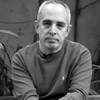 Eduardo Muñoz Ordoqui (Cuba, 1964). Photographer. He received a Bachelor in Fine Arts degree in History of Art from the University of Havana in 1990 and a Master in Fine Arts in Studio Art from the University of Texas at Austin in 2005. He has taught photography for more than nine years in St. Edward’s University at Austin, Texas, where he is currently a Faculty Associate at the Department of Visual Studies. Muñoz-Ordoqui’s photographic work has been exhibited in solo and group shows in Europe, Latin America, China, and United States. He received a John Simon Guggenheim Memorial Foundation Fellowship in 1997, a Cintas Foundation Fellowship in 1998 and in 2007 was chosen for the Artpace International Artist-in-Residence program in San Antonio, Texas, USA. His photographs are held in private and institutional collections in the Americas and Europe.
Eduardo Muñoz Ordoqui (Cuba, 1964). Photographer. He received a Bachelor in Fine Arts degree in History of Art from the University of Havana in 1990 and a Master in Fine Arts in Studio Art from the University of Texas at Austin in 2005. He has taught photography for more than nine years in St. Edward’s University at Austin, Texas, where he is currently a Faculty Associate at the Department of Visual Studies. Muñoz-Ordoqui’s photographic work has been exhibited in solo and group shows in Europe, Latin America, China, and United States. He received a John Simon Guggenheim Memorial Foundation Fellowship in 1997, a Cintas Foundation Fellowship in 1998 and in 2007 was chosen for the Artpace International Artist-in-Residence program in San Antonio, Texas, USA. His photographs are held in private and institutional collections in the Americas and Europe.Interview with Eduardo Muñoz. April 2015
 Eduardo Muñoz Ordoqui (Cuba, 1964). Photographer. He received a Bachelor in Fine Arts degree in History of Art from the University of Havana in 1990 and a Master in Fine Arts in Studio Art from the University of Texas at Austin in 2005. He has taught photography for more than nine years in St. Edward’s University at Austin, Texas, where he is currently a Faculty Associate at the Department of Visual Studies. Muñoz-Ordoqui’s photographic work has been exhibited in solo and group shows in Europe, Latin America, China, and United States. He received a John Simon Guggenheim Memorial Foundation Fellowship in 1997, a Cintas Foundation Fellowship in 1998 and in 2007 was chosen for the Artpace International Artist-in-Residence program in San Antonio, Texas, USA. His photographs are held in private and institutional collections in the Americas and Europe.
Eduardo Muñoz Ordoqui (Cuba, 1964). Photographer. He received a Bachelor in Fine Arts degree in History of Art from the University of Havana in 1990 and a Master in Fine Arts in Studio Art from the University of Texas at Austin in 2005. He has taught photography for more than nine years in St. Edward’s University at Austin, Texas, where he is currently a Faculty Associate at the Department of Visual Studies. Muñoz-Ordoqui’s photographic work has been exhibited in solo and group shows in Europe, Latin America, China, and United States. He received a John Simon Guggenheim Memorial Foundation Fellowship in 1997, a Cintas Foundation Fellowship in 1998 and in 2007 was chosen for the Artpace International Artist-in-Residence program in San Antonio, Texas, USA. His photographs are held in private and institutional collections in the Americas and Europe.Mauricio Alejo
In relation to his videos Mauricio shared the following reflexion with us, that was part of an interview he gave:
Recently I was interviewed by Katrin Steffen. She asked me what I thought of the idea of my videos being surreal. The question caught me off guard; not that I was completely unaware of this, let’s say, approach to my work - other people have made the same observation - but it was the direct, straightforward way in which she formulated her question that struck me.
It is interesting that, until then, I had been resisting calling my work surreal. I don’t know why. I just unreflectively didn't like the idea, but once the question was out I had no option but to come to terms with what I was so stubbornly denying.
Answering it was both liberating and enlightening. I came to understand that, indeed, there is a strong surreal element to my work, probably “á la Magritte” as in “This is not a Pipe” (as opposed to “á la Dalí”, whose work I dislike; it is too spectacular for my taste).
Either way, what I can say is that I’m not trying to open a door to the unconscious, but to a more obvious and factual world that is still surprising, because it actually exists and is just hidden in plain sight.
These lines show a desire to offer a new way of looking at a universe that is hidden behind the false transparency of the photographic language.
In several of the works presented here, our reading of a still image is transformed—thanks to the passage of time—into something completely different. The surprising elements in the universe are infinitely more casual. Gravity, in an unforeseen twist, belies the lightness of the air.
In all of them, the passage of time is a necessary element to show that photography can be a map of the reality but is not equal to it, like for example in the piece World: the world that not stops to move is different from the world that not stops to move around it, and in turn different from our world that also does not slow down.
| Universe |
Line |
Hole |
| Gravity |
Twig |
Crack |
| Container |
Fact and fiction |
World |
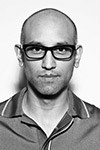 Mauricio Alejo (Mexico, 1969). He earned his Master of Art from New York University in 2002, as a Fulbright Grant recipient. In 2007, he was a resident artist at NUS Centre for the Arts in Singapore. He has received multiple awards and grants, including the New York Foundation for the Arts grant in 2008. His work is part of important collections such as Daros Latinoamérica Collection in Zürich . His work has been reviewed in important journals, such as Flash Art; Art News and Art in America. He has had solo exhibitions in New York, Japan, Madrid, Paris and Mexico. His work has been shown at CCA Wattis Institute of Contemporary Arts in San Francisco; Museo Centro de Arte Reina Sofía in Madrid and The 8th Havana Biennial among other venues. He currently lives and works in New York City.
Mauricio Alejo (Mexico, 1969). He earned his Master of Art from New York University in 2002, as a Fulbright Grant recipient. In 2007, he was a resident artist at NUS Centre for the Arts in Singapore. He has received multiple awards and grants, including the New York Foundation for the Arts grant in 2008. His work is part of important collections such as Daros Latinoamérica Collection in Zürich . His work has been reviewed in important journals, such as Flash Art; Art News and Art in America. He has had solo exhibitions in New York, Japan, Madrid, Paris and Mexico. His work has been shown at CCA Wattis Institute of Contemporary Arts in San Francisco; Museo Centro de Arte Reina Sofía in Madrid and The 8th Havana Biennial among other venues. He currently lives and works in New York City.In relation to his videos Mauricio shared the following reflexion with us, that was part of an interview he gave:
Recently I was interviewed by Katrin Steffen. She asked me what I thought of the idea of my videos being surreal. The question caught me off guard; not that I was completely unaware of this, let’s say, approach to my work - other people have made the same observation - but it was the direct, straightforward way in which she formulated her question that struck me.
It is interesting that, until then, I had been resisting calling my work surreal. I don’t know why. I just unreflectively didn't like the idea, but once the question was out I had no option but to come to terms with what I was so stubbornly denying.
Answering it was both liberating and enlightening. I came to understand that, indeed, there is a strong surreal element to my work, probably “á la Magritte” as in “This is not a Pipe” (as opposed to “á la Dalí”, whose work I dislike; it is too spectacular for my taste).
Either way, what I can say is that I’m not trying to open a door to the unconscious, but to a more obvious and factual world that is still surprising, because it actually exists and is just hidden in plain sight.
These lines show a desire to offer a new way of looking at a universe that is hidden behind the false transparency of the photographic language.
In several of the works presented here, our reading of a still image is transformed—thanks to the passage of time—into something completely different. The surprising elements in the universe are infinitely more casual. Gravity, in an unforeseen twist, belies the lightness of the air.
In all of them, the passage of time is a necessary element to show that photography can be a map of the reality but is not equal to it, like for example in the piece World: the world that not stops to move is different from the world that not stops to move around it, and in turn different from our world that also does not slow down.
| Universe |
Line |
Hole |
| Gravity |
Twig |
Crack |
| Container |
Fact and fiction |
World |
 Mauricio Alejo (Mexico, 1969). He earned his Master of Art from New York University in 2002, as a Fulbright Grant recipient. In 2007, he was a resident artist at NUS Centre for the Arts in Singapore. He has received multiple awards and grants, including the New York Foundation for the Arts grant in 2008. His work is part of important collections such as Daros Latinoamérica Collection in Zürich . His work has been reviewed in important journals, such as Flash Art; Art News and Art in America. He has had solo exhibitions in New York, Japan, Madrid, Paris and Mexico. His work has been shown at CCA Wattis Institute of Contemporary Arts in San Francisco; Museo Centro de Arte Reina Sofía in Madrid and The 8th Havana Biennial among other venues. He currently lives and works in New York City.
Mauricio Alejo (Mexico, 1969). He earned his Master of Art from New York University in 2002, as a Fulbright Grant recipient. In 2007, he was a resident artist at NUS Centre for the Arts in Singapore. He has received multiple awards and grants, including the New York Foundation for the Arts grant in 2008. His work is part of important collections such as Daros Latinoamérica Collection in Zürich . His work has been reviewed in important journals, such as Flash Art; Art News and Art in America. He has had solo exhibitions in New York, Japan, Madrid, Paris and Mexico. His work has been shown at CCA Wattis Institute of Contemporary Arts in San Francisco; Museo Centro de Arte Reina Sofía in Madrid and The 8th Havana Biennial among other venues. He currently lives and works in New York City.Virgil Widrich
Copy Shop, 2001
Written, directed, produced, edited by Virgil Widrich
An original copy film. 2001, 35mm. b/w, 12 min. sound, no dialogue.
The film Copy Shop actually consist of nearly 18,000 photocopied digital frames, which are animated and filmed with a 35mm camera.
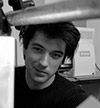 Virgil Widrich (Salzburg, 1967). Lives in Vienna. He works on numerous multimedia and film productions. His first feature film is Heller als der Mond (Brighter than the Moon). His short film Copy Shop won 35 international awards and was nominated for the Oscar. Fast Film premiered in Cannes 2003 and won 36 awards until today. At the moment Widrich is working on a new feature film The Night of a Thousand Hours.
Virgil Widrich (Salzburg, 1967). Lives in Vienna. He works on numerous multimedia and film productions. His first feature film is Heller als der Mond (Brighter than the Moon). His short film Copy Shop won 35 international awards and was nominated for the Oscar. Fast Film premiered in Cannes 2003 and won 36 awards until today. At the moment Widrich is working on a new feature film The Night of a Thousand Hours.Copy Shop, 2001
Written, directed, produced, edited by Virgil Widrich
An original copy film. 2001, 35mm. b/w, 12 min. sound, no dialogue.
The film Copy Shop actually consist of nearly 18,000 photocopied digital frames, which are animated and filmed with a 35mm camera.
 Virgil Widrich (Salzburg, 1967). Lives in Vienna. He works on numerous multimedia and film productions. His first feature film is Heller als der Mond (Brighter than the Moon). His short film Copy Shop won 35 international awards and was nominated for the Oscar. Fast Film premiered in Cannes 2003 and won 36 awards until today. At the moment Widrich is working on a new feature film The Night of a Thousand Hours.
Virgil Widrich (Salzburg, 1967). Lives in Vienna. He works on numerous multimedia and film productions. His first feature film is Heller als der Mond (Brighter than the Moon). His short film Copy Shop won 35 international awards and was nominated for the Oscar. Fast Film premiered in Cannes 2003 and won 36 awards until today. At the moment Widrich is working on a new feature film The Night of a Thousand Hours.ZoneZero
Interview with Caspar Sonnen about interactive storytelling. February 2015
 Caspar Sonnen. Studied New Media and Film at Utrecht University. He has worked for film and media art festivals. In 2003, he co-founded Seize the Night, an open air film festival in Amsterdam. In 2005, Sonnen became the new media coordinator for the International Documentary Film Festival Amsterdam (IDFA). In 2008, he launched IDFA DocLab. The program quickly grew into an international platform for interactive webdocs and other new genres where digital technology and documentary storytelling converge.
Caspar Sonnen. Studied New Media and Film at Utrecht University. He has worked for film and media art festivals. In 2003, he co-founded Seize the Night, an open air film festival in Amsterdam. In 2005, Sonnen became the new media coordinator for the International Documentary Film Festival Amsterdam (IDFA). In 2008, he launched IDFA DocLab. The program quickly grew into an international platform for interactive webdocs and other new genres where digital technology and documentary storytelling converge.Interview with Caspar Sonnen about interactive storytelling. February 2015
 Caspar Sonnen. Studied New Media and Film at Utrecht University. He has worked for film and media art festivals. In 2003, he co-founded Seize the Night, an open air film festival in Amsterdam. In 2005, Sonnen became the new media coordinator for the International Documentary Film Festival Amsterdam (IDFA). In 2008, he launched IDFA DocLab. The program quickly grew into an international platform for interactive webdocs and other new genres where digital technology and documentary storytelling converge.
Caspar Sonnen. Studied New Media and Film at Utrecht University. He has worked for film and media art festivals. In 2003, he co-founded Seize the Night, an open air film festival in Amsterdam. In 2005, Sonnen became the new media coordinator for the International Documentary Film Festival Amsterdam (IDFA). In 2008, he launched IDFA DocLab. The program quickly grew into an international platform for interactive webdocs and other new genres where digital technology and documentary storytelling converge.ZoneZero
Interview with Virgil Widrich about his work. February 2015
 Virgil Widrich (Salzburg, 1967). Lives in Vienna. He works on numerous multimedia and film productions. His first feature film is Heller als der Mond (Brighter than the Moon). His short film Copy Shop won 35 international awards and was nominated for the Oscar. Fast Film premiered in Cannes 2003 and won 36 awards until today. At the moment Widrich is working on a new feature film The Night of a Thousand Hours.
Virgil Widrich (Salzburg, 1967). Lives in Vienna. He works on numerous multimedia and film productions. His first feature film is Heller als der Mond (Brighter than the Moon). His short film Copy Shop won 35 international awards and was nominated for the Oscar. Fast Film premiered in Cannes 2003 and won 36 awards until today. At the moment Widrich is working on a new feature film The Night of a Thousand Hours.Interview with Virgil Widrich about his work. February 2015
 Virgil Widrich (Salzburg, 1967). Lives in Vienna. He works on numerous multimedia and film productions. His first feature film is Heller als der Mond (Brighter than the Moon). His short film Copy Shop won 35 international awards and was nominated for the Oscar. Fast Film premiered in Cannes 2003 and won 36 awards until today. At the moment Widrich is working on a new feature film The Night of a Thousand Hours.
Virgil Widrich (Salzburg, 1967). Lives in Vienna. He works on numerous multimedia and film productions. His first feature film is Heller als der Mond (Brighter than the Moon). His short film Copy Shop won 35 international awards and was nominated for the Oscar. Fast Film premiered in Cannes 2003 and won 36 awards until today. At the moment Widrich is working on a new feature film The Night of a Thousand Hours.Zone Zero
Andy Joule uses a combination of traditional and digital techniques, such as stop-motion, multi-layered image sequences and time-lapse. His time-lapses are more than just a technical sensation, closer to the fields of experimental video or fictional documentary. Time becomes the protagonist. Objects that seem to be inert at first, begin to change; a process that only becomes visible by the layer of time that is put over the presented sequences. In this way, the work of Joule brings about the manipulation, deconstruction and reinterpretation of time and space, proposing unconventional narratives and new ways of understanding time in short audiovisual formats.
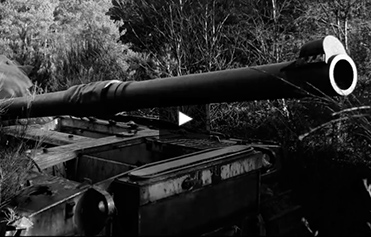 SALVAGE
SALVAGEInspired by a quote from the naturalist Jacques Yves Cousteau, this film explores the way in which nature clings to life, finds a foothold, and ultimately reclaims what is hers. The solidity of these metal beasts is questioned as the rust and flake slowly leak into the ground.
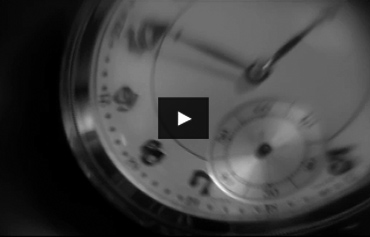 ELIPSIS
ELIPSIS Andy Joule is a film-maker and animator. He studied animation at West Surrey College of Art & Design. After graduating he worked in London, Manchester, Bristol, the Netherlands and in the US. His films have been screened in festivals and competitions around the world. He has lectured at Volda University College, Norway and is a Senior Lecturer in Animation at the University for the Creative Arts. He is also a BAFTA juror and a Fellow of the Royal Society of Arts.
Andy Joule is a film-maker and animator. He studied animation at West Surrey College of Art & Design. After graduating he worked in London, Manchester, Bristol, the Netherlands and in the US. His films have been screened in festivals and competitions around the world. He has lectured at Volda University College, Norway and is a Senior Lecturer in Animation at the University for the Creative Arts. He is also a BAFTA juror and a Fellow of the Royal Society of Arts.Andy Joule uses a combination of traditional and digital techniques, such as stop-motion, multi-layered image sequences and time-lapse. His time-lapses are more than just a technical sensation, closer to the fields of experimental video or fictional documentary. Time becomes the protagonist. Objects that seem to be inert at first, begin to change; a process that only becomes visible by the layer of time that is put over the presented sequences. In this way, the work of Joule brings about the manipulation, deconstruction and reinterpretation of time and space, proposing unconventional narratives and new ways of understanding time in short audiovisual formats.
 SALVAGE
SALVAGEInspired by a quote from the naturalist Jacques Yves Cousteau, this film explores the way in which nature clings to life, finds a foothold, and ultimately reclaims what is hers. The solidity of these metal beasts is questioned as the rust and flake slowly leak into the ground.
 ELIPSIS
ELIPSIS Andy Joule is a film-maker and animator. He studied animation at West Surrey College of Art & Design. After graduating he worked in London, Manchester, Bristol, the Netherlands and in the US. His films have been screened in festivals and competitions around the world. He has lectured at Volda University College, Norway and is a Senior Lecturer in Animation at the University for the Creative Arts. He is also a BAFTA juror and a Fellow of the Royal Society of Arts.
Andy Joule is a film-maker and animator. He studied animation at West Surrey College of Art & Design. After graduating he worked in London, Manchester, Bristol, the Netherlands and in the US. His films have been screened in festivals and competitions around the world. He has lectured at Volda University College, Norway and is a Senior Lecturer in Animation at the University for the Creative Arts. He is also a BAFTA juror and a Fellow of the Royal Society of Arts.Matthew Hashiguchi
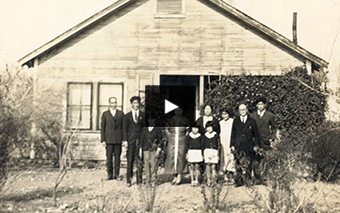 Good Luck Soup
Good Luck SoupIs a transmedia storytelling project documenting and sharing stories of the Japanese American and Japanese Canadian experience after they left the internment camps. The project consists of a feature-length documentary film, titled Good Luck Soup and an interactive, participatory website, Good Luck Soup Interactive. On this website stories will be told through uploaded text and photographs from internment camp victims, or their families, and will be shared through an interactive website and map.
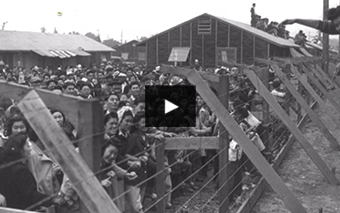 People Aren't All Bad
People Aren't All BadZZ. What has been the reaction of the public to your invitation to participate in your transmedia storytelling project?
MH. We've had a consistently positive response from the Japanese American/Canadian community. Initially, I think many have been nervous about sharing their own stories and experiences, but once we sit down with them and talk about their life, they tend to open up. It's been a form of catharsis, I think, because many people have never discussed their issues or experiences of being Japanese American/Canadian... and some of these things are very difficult topics or thoughts that have been bottled up. So, it's a very emotional experience to share these thoughts and feelings. We haven't yet opened it up to the general public, but again, everyone has been consistently positive, and I have no reason to think the reaction will be any different once its available to all Japanese Americans and Japanese Canadians.
ZZ. What means of publicity are you using or are you planning to use for the diffusion of the project?
MH. Social media will be a huge tool for publicity and marketing. We've already reached and met so many people through Twitter and Facebook, and we'll certainly continue to utilize those outlets. We've been in communication with many Asian American and Asian Canadian organizations that have offered their support once the project is complete, and the opportunity to collaborate with entities such as the Japanese American Citizens League, the Japanese American National Museum and the Nikkei National Museum would be priceless. We're certainly inspired by their mission and view our project as a continuation of what they offer the public.
In addition to the interactive documentary, this project also includes a feature length film. Film festivals will be another great opportunity to screen the film and present the interactive project to an audience.
ZZ. Can you share with us how you have experienced the realisation, dissemination and the reach of the project thus far?
MH. It's been a very gradual and collaborative process, and luckily I have an incredible team of colleagues and friends that have made the realization of this project possible, and without their help, I would not have been able to get this project made. The work load is split up fairly well. Right now, our web-designer/coder (Russell Goldenberg) is building the site. He's the one sitting alone typing away at his computer. Every few weeks, we'll all have a meeting where we discuss the direction of the project... and then Russell goes and brings it to life. Billy Wirasnik, Emily Ferrier and myself and have been in charge of content aggregation. So we're narrowing the aim of the stories and in many cases, going out and finding those stories and individuals. It's a solid collaboration made up of various creative visions, rather than one. And, as the Project Creator, I really enjoy a hands-off approach that allows individuals to run off with an idea and make it their own.
 Matthew Hashiguchi (1984). Based in Boston, Massachusetts. After graduating from The Ohio State University in 2007 with a BA in Photojournalism, Matthew went on to work and intern as a multimedia journalist for The Findlay Courier, The Lima News and The Washington Post. In 2008, he returned to school and graduated from Emerson College with an MFA in Visual and Media Art and has since been working as an independent documentary filmmaker and educator, whose work focuses on the diverse cultural, social and ethnic stories of American society. For his film The Lower 9 he has received various awards.
Matthew Hashiguchi (1984). Based in Boston, Massachusetts. After graduating from The Ohio State University in 2007 with a BA in Photojournalism, Matthew went on to work and intern as a multimedia journalist for The Findlay Courier, The Lima News and The Washington Post. In 2008, he returned to school and graduated from Emerson College with an MFA in Visual and Media Art and has since been working as an independent documentary filmmaker and educator, whose work focuses on the diverse cultural, social and ethnic stories of American society. For his film The Lower 9 he has received various awards. Good Luck Soup
Good Luck SoupIs a transmedia storytelling project documenting and sharing stories of the Japanese American and Japanese Canadian experience after they left the internment camps. The project consists of a feature-length documentary film, titled Good Luck Soup and an interactive, participatory website, Good Luck Soup Interactive. On this website stories will be told through uploaded text and photographs from internment camp victims, or their families, and will be shared through an interactive website and map.
 People Aren't All Bad
People Aren't All BadZZ. What has been the reaction of the public to your invitation to participate in your transmedia storytelling project?
MH. We've had a consistently positive response from the Japanese American/Canadian community. Initially, I think many have been nervous about sharing their own stories and experiences, but once we sit down with them and talk about their life, they tend to open up. It's been a form of catharsis, I think, because many people have never discussed their issues or experiences of being Japanese American/Canadian... and some of these things are very difficult topics or thoughts that have been bottled up. So, it's a very emotional experience to share these thoughts and feelings. We haven't yet opened it up to the general public, but again, everyone has been consistently positive, and I have no reason to think the reaction will be any different once its available to all Japanese Americans and Japanese Canadians.
ZZ. What means of publicity are you using or are you planning to use for the diffusion of the project?
MH. Social media will be a huge tool for publicity and marketing. We've already reached and met so many people through Twitter and Facebook, and we'll certainly continue to utilize those outlets. We've been in communication with many Asian American and Asian Canadian organizations that have offered their support once the project is complete, and the opportunity to collaborate with entities such as the Japanese American Citizens League, the Japanese American National Museum and the Nikkei National Museum would be priceless. We're certainly inspired by their mission and view our project as a continuation of what they offer the public.
In addition to the interactive documentary, this project also includes a feature length film. Film festivals will be another great opportunity to screen the film and present the interactive project to an audience.
ZZ. Can you share with us how you have experienced the realisation, dissemination and the reach of the project thus far?
MH. It's been a very gradual and collaborative process, and luckily I have an incredible team of colleagues and friends that have made the realization of this project possible, and without their help, I would not have been able to get this project made. The work load is split up fairly well. Right now, our web-designer/coder (Russell Goldenberg) is building the site. He's the one sitting alone typing away at his computer. Every few weeks, we'll all have a meeting where we discuss the direction of the project... and then Russell goes and brings it to life. Billy Wirasnik, Emily Ferrier and myself and have been in charge of content aggregation. So we're narrowing the aim of the stories and in many cases, going out and finding those stories and individuals. It's a solid collaboration made up of various creative visions, rather than one. And, as the Project Creator, I really enjoy a hands-off approach that allows individuals to run off with an idea and make it their own.
 Matthew Hashiguchi (1984). Based in Boston, Massachusetts. After graduating from The Ohio State University in 2007 with a BA in Photojournalism, Matthew went on to work and intern as a multimedia journalist for The Findlay Courier, The Lima News and The Washington Post. In 2008, he returned to school and graduated from Emerson College with an MFA in Visual and Media Art and has since been working as an independent documentary filmmaker and educator, whose work focuses on the diverse cultural, social and ethnic stories of American society. For his film The Lower 9 he has received various awards.
Matthew Hashiguchi (1984). Based in Boston, Massachusetts. After graduating from The Ohio State University in 2007 with a BA in Photojournalism, Matthew went on to work and intern as a multimedia journalist for The Findlay Courier, The Lima News and The Washington Post. In 2008, he returned to school and graduated from Emerson College with an MFA in Visual and Media Art and has since been working as an independent documentary filmmaker and educator, whose work focuses on the diverse cultural, social and ethnic stories of American society. For his film The Lower 9 he has received various awards.Josef Wladyka

My mother left Japan more than thirty years ago and didn't return until November 2010. This is her story.
Location: Tokyo, Japan.
Cinematography: Stan Wladyka.
Music: Tyler Parkinson.
Okaasan お母さん
Beginning as a child performer in Odessa, Russia, Albert Makhtsier has been acting for over half a century. Despite being diagnosed with Parkinson's disease, Albert remains one of New York City's finest actors. This is his story.
Location: Times Square, New York City.
Cinematography: Alan Blanco.
Music: Tyler Cash.
Albert Makhtsier
Curai is a small, tight knit fishing village on the Southern Pacific Coast of Colombia. It's a place where almost everyone shares the same last name. Jacobo is a community leader there and this is one of his stories.
Location: Curai, Colombia.
Cinematography by Leonardo D'Antoni.
Music by Tyler Cash.
Jacobo Castillo Salazar
These are a collection of peoples' personal stories told through a single shot. Each story is an exploration of the universal essence of the human condition and our connection to one another that extends beyond any boundaries.
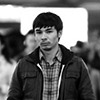 Josef Wladyka. Lives in New York. Influenced by his parents, Josef developed a fascination for movies from a very young age. He began experimenting with filmmaking in high school and has since created several (short) films and commercials that have been screened at festivals around the world. He holds a MFA from NYU Tisch Graduate Film where he won a Spike Lee Fellowship. His debut feature film, Manos Sucias (2014), has won various awards.
Josef Wladyka. Lives in New York. Influenced by his parents, Josef developed a fascination for movies from a very young age. He began experimenting with filmmaking in high school and has since created several (short) films and commercials that have been screened at festivals around the world. He holds a MFA from NYU Tisch Graduate Film where he won a Spike Lee Fellowship. His debut feature film, Manos Sucias (2014), has won various awards.
My mother left Japan more than thirty years ago and didn't return until November 2010. This is her story.
Location: Tokyo, Japan.
Cinematography: Stan Wladyka.
Music: Tyler Parkinson.
Okaasan お母さん
Beginning as a child performer in Odessa, Russia, Albert Makhtsier has been acting for over half a century. Despite being diagnosed with Parkinson's disease, Albert remains one of New York City's finest actors. This is his story.
Location: Times Square, New York City.
Cinematography: Alan Blanco.
Music: Tyler Cash.
Albert Makhtsier
Curai is a small, tight knit fishing village on the Southern Pacific Coast of Colombia. It's a place where almost everyone shares the same last name. Jacobo is a community leader there and this is one of his stories.
Location: Curai, Colombia.
Cinematography by Leonardo D'Antoni.
Music by Tyler Cash.
Jacobo Castillo Salazar
These are a collection of peoples' personal stories told through a single shot. Each story is an exploration of the universal essence of the human condition and our connection to one another that extends beyond any boundaries.
 Josef Wladyka. Lives in New York. Influenced by his parents, Josef developed a fascination for movies from a very young age. He began experimenting with filmmaking in high school and has since created several (short) films and commercials that have been screened at festivals around the world. He holds a MFA from NYU Tisch Graduate Film where he won a Spike Lee Fellowship. His debut feature film, Manos Sucias (2014), has won various awards.
Josef Wladyka. Lives in New York. Influenced by his parents, Josef developed a fascination for movies from a very young age. He began experimenting with filmmaking in high school and has since created several (short) films and commercials that have been screened at festivals around the world. He holds a MFA from NYU Tisch Graduate Film where he won a Spike Lee Fellowship. His debut feature film, Manos Sucias (2014), has won various awards.Antonio Contreras & Rafael Torrado
We stopped for a smoke under a bridge and saw three characters seated on a couch in front of a large stone screen. We told them we were photographers and wanted to take their picture. In the beginning they were shy (we were too) and we began by taking pictures of the place: the living room, the bathroom, the house, the garden. We gradually got to know each other better. They liked our idea and we visited them a couple more times. One day, everything was gone; neither a trace of them nor their belongings remained. We decided to investigate what had happened on the other side of the bridge, where people had also settled.
That is where we met Manuelín, the owner of a small house located between the light rail tracks of Mexico City and an overpass. We asked him about our vanished acquaintances, and he said that a there had been a police operation and a number of people had been arrested. We never found out anything else; no one knew their names. Manuelín and his friends welcomed us from the start and that same day they took us to "The Den", a place where the floor is made up of an immense mass of clothing and garbage, where rats and cockroaches turn up at every step. It was a place that was abandoned by the group after being flooded with rain water.
This is how The Best of the Worst was born, initially a photographic and then a video project that is midway between documentary and fiction, anthropology and journalism.
The photographs that comprise the first portion of this work result from the spontaneity and imagination of Manuelín and company, as well as from a constant effort to capture various moments of these characters in their own space: a peaceful afternoon “chilling” on the bridge, a hot day spent drinking amidst trucks and trains, a nighttime party and the next morning’s hangover.
This is their story.
 Antonio Contreras (Mexico). Lives and works in Mexico City. He studied social communication at the Universidad Autónoma Metropolitana. In 2014 he participated in the diploma course Photo Narrative and New Media from the Pedro Meyer Foundation. He regularly publishes in the collective blog Parteuno
Antonio Contreras (Mexico). Lives and works in Mexico City. He studied social communication at the Universidad Autónoma Metropolitana. In 2014 he participated in the diploma course Photo Narrative and New Media from the Pedro Meyer Foundation. He regularly publishes in the collective blog Parteuno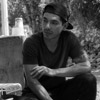 Rafael Torrado (Mexico). Mexican photographer born in Mexico City. Bachelor student in Social Communication at the Universidad Autónoma Metropolitana. Since 2011 he has worked in the field of documentary photography, where he develops the subjects of violence, drugs, discrimination and social movements.
Rafael Torrado (Mexico). Mexican photographer born in Mexico City. Bachelor student in Social Communication at the Universidad Autónoma Metropolitana. Since 2011 he has worked in the field of documentary photography, where he develops the subjects of violence, drugs, discrimination and social movements.
We stopped for a smoke under a bridge and saw three characters seated on a couch in front of a large stone screen. We told them we were photographers and wanted to take their picture. In the beginning they were shy (we were too) and we began by taking pictures of the place: the living room, the bathroom, the house, the garden. We gradually got to know each other better. They liked our idea and we visited them a couple more times. One day, everything was gone; neither a trace of them nor their belongings remained. We decided to investigate what had happened on the other side of the bridge, where people had also settled.
That is where we met Manuelín, the owner of a small house located between the light rail tracks of Mexico City and an overpass. We asked him about our vanished acquaintances, and he said that a there had been a police operation and a number of people had been arrested. We never found out anything else; no one knew their names. Manuelín and his friends welcomed us from the start and that same day they took us to "The Den", a place where the floor is made up of an immense mass of clothing and garbage, where rats and cockroaches turn up at every step. It was a place that was abandoned by the group after being flooded with rain water.
This is how The Best of the Worst was born, initially a photographic and then a video project that is midway between documentary and fiction, anthropology and journalism.
The photographs that comprise the first portion of this work result from the spontaneity and imagination of Manuelín and company, as well as from a constant effort to capture various moments of these characters in their own space: a peaceful afternoon “chilling” on the bridge, a hot day spent drinking amidst trucks and trains, a nighttime party and the next morning’s hangover.
This is their story.
 Antonio Contreras (Mexico). Lives and works in Mexico City. He studied social communication at the Universidad Autónoma Metropolitana. In 2014 he participated in the diploma course Photo Narrative and New Media from the Pedro Meyer Foundation. He regularly publishes in the collective blog Parteuno
Antonio Contreras (Mexico). Lives and works in Mexico City. He studied social communication at the Universidad Autónoma Metropolitana. In 2014 he participated in the diploma course Photo Narrative and New Media from the Pedro Meyer Foundation. He regularly publishes in the collective blog Parteuno Rafael Torrado (Mexico). Mexican photographer born in Mexico City. Bachelor student in Social Communication at the Universidad Autónoma Metropolitana. Since 2011 he has worked in the field of documentary photography, where he develops the subjects of violence, drugs, discrimination and social movements.
Rafael Torrado (Mexico). Mexican photographer born in Mexico City. Bachelor student in Social Communication at the Universidad Autónoma Metropolitana. Since 2011 he has worked in the field of documentary photography, where he develops the subjects of violence, drugs, discrimination and social movements.Victor Enrich
In 2013 Enrich produced NHDK, a series of 88 manipulated photographs - one for each piano key classical - of the Deutscher Kaiser hotel in Munich. The images, which all display the building from the same angle, imagine it variously with parts rotated, duplicated, removed and floating in the sky.
I find beautiful to connect two different disciplines, such as digital photography and graphic arts with piano. —Victor Enrich.
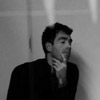 Victor Enrich (Spain, 1976). A catalan artist and a lover of nature, literature and architecture. Since childhood has been dedicated through various techniques to create images of fictional scenarios, always linking cities and architecture. Enrich currently dedicated exclusively to the development of his art, which is inseparably associated with his other great passion: traveling. Their work is highly valued abroad and he has succeeded in countries like Israel, where he has made several exhibitions.
Victor Enrich (Spain, 1976). A catalan artist and a lover of nature, literature and architecture. Since childhood has been dedicated through various techniques to create images of fictional scenarios, always linking cities and architecture. Enrich currently dedicated exclusively to the development of his art, which is inseparably associated with his other great passion: traveling. Their work is highly valued abroad and he has succeeded in countries like Israel, where he has made several exhibitions.In 2013 Enrich produced NHDK, a series of 88 manipulated photographs - one for each piano key classical - of the Deutscher Kaiser hotel in Munich. The images, which all display the building from the same angle, imagine it variously with parts rotated, duplicated, removed and floating in the sky.
I find beautiful to connect two different disciplines, such as digital photography and graphic arts with piano. —Victor Enrich.
 Victor Enrich (Spain, 1976). A catalan artist and a lover of nature, literature and architecture. Since childhood has been dedicated through various techniques to create images of fictional scenarios, always linking cities and architecture. Enrich currently dedicated exclusively to the development of his art, which is inseparably associated with his other great passion: traveling. Their work is highly valued abroad and he has succeeded in countries like Israel, where he has made several exhibitions.
Victor Enrich (Spain, 1976). A catalan artist and a lover of nature, literature and architecture. Since childhood has been dedicated through various techniques to create images of fictional scenarios, always linking cities and architecture. Enrich currently dedicated exclusively to the development of his art, which is inseparably associated with his other great passion: traveling. Their work is highly valued abroad and he has succeeded in countries like Israel, where he has made several exhibitions.Noah Kalina
Noah Kalina has been taking a photograph of himself every day since January 2000. Originally it was meant to be a photo project, but in 2006 he was inspired by a project by Ahree Lee, a graphic designer from California who had put a time-lapse video of herself on YouTube. Noah decided to do the same with his self-portraits and, within three weeks, it became an international internet sensation.
 Noah Kalina (US, 1980) is a photographer based in Brooklyn and Lumberland, New York. He graduated from the School of Visual Arts with a BFA in photography. His project ‘Everyday’ was a worldwide hit. His work has been exhibited all over the world: in the U.S., Switzerland, Italy, Belgium, France, Australia, England, Canada, Germany and the Netherlands. He also has given lectures in various countries. To see more of his work go to: noahkalina.com
Noah Kalina (US, 1980) is a photographer based in Brooklyn and Lumberland, New York. He graduated from the School of Visual Arts with a BFA in photography. His project ‘Everyday’ was a worldwide hit. His work has been exhibited all over the world: in the U.S., Switzerland, Italy, Belgium, France, Australia, England, Canada, Germany and the Netherlands. He also has given lectures in various countries. To see more of his work go to: noahkalina.comNoah Kalina has been taking a photograph of himself every day since January 2000. Originally it was meant to be a photo project, but in 2006 he was inspired by a project by Ahree Lee, a graphic designer from California who had put a time-lapse video of herself on YouTube. Noah decided to do the same with his self-portraits and, within three weeks, it became an international internet sensation.
 Noah Kalina (US, 1980) is a photographer based in Brooklyn and Lumberland, New York. He graduated from the School of Visual Arts with a BFA in photography. His project ‘Everyday’ was a worldwide hit. His work has been exhibited all over the world: in the U.S., Switzerland, Italy, Belgium, France, Australia, England, Canada, Germany and the Netherlands. He also has given lectures in various countries. To see more of his work go to: noahkalina.com
Noah Kalina (US, 1980) is a photographer based in Brooklyn and Lumberland, New York. He graduated from the School of Visual Arts with a BFA in photography. His project ‘Everyday’ was a worldwide hit. His work has been exhibited all over the world: in the U.S., Switzerland, Italy, Belgium, France, Australia, England, Canada, Germany and the Netherlands. He also has given lectures in various countries. To see more of his work go to: noahkalina.comCatherine Balet
 Catherine Balet (France, 1959). Lives and works between Paris and Brighton. She graduated at the Ecole des Beaux Arts in Paris and worked as an artist before turning to Photography ten years ago. As a freelancer, she has been a regular contributor to various french and international magazines, also creating images for the world of fashion. She has today specialised in portraiture with an artistico-sociological approach of her subjects. To see more of her work go to: catherinebalet.
Catherine Balet (France, 1959). Lives and works between Paris and Brighton. She graduated at the Ecole des Beaux Arts in Paris and worked as an artist before turning to Photography ten years ago. As a freelancer, she has been a regular contributor to various french and international magazines, also creating images for the world of fashion. She has today specialised in portraiture with an artistico-sociological approach of her subjects. To see more of her work go to: catherinebalet.ZZ. Identity is an important theme in your work. How do you think identity is effected by the social media and new technologies?
CB. I am mainly interested in the quest for identity because it is a very revealing process of creativity and sociology. I try to depict young people in search of identity for the reason that teenagers are very innovative with the tools they use to express themselves. Ten years ago, I started a photographic series on the expression of identity through clothes, brands, trends and groups, as it was a very intense phenomenon at that time. This naturally brought me to technology, the devices having replaced the clothes as medium of self-expression. "Selfies" allow teenagers, who are going through the complex process of the creation of their identity, to be themselves and at the same time to be like the ones they admire. The disposable and renewable images they make of themselves are the best expression of the permanent changes they are experiencing. The fact that they can renew their profile and follow the group that they have chosen by conforming to codes of representation is essential in developing their identity. It allows them to validate their opinions and determine the appropriateness of their attitudes and behaviours. Teenagers have an enhanced need for self-presentation. Communicating their identity to others works as an act of auto-revelation. Mobile phones have become a sort of digital prosthesis which connects the "real me" to the "virtual me” through social networks, creating a double personality.
ZZ. I love myself, I love me, I do refers to the narcissistic self-awareness expressed on social networks. Do you consider 'the selfie' to be only a product of narcissism or do you think there is more to it?
CB. Narcissus was in love with himself and not looking for interaction. I think that taking a "selfie" is not a self-centred act but a way to become affiliated to a large universal community. "Selfies" are social portraits created in order to open up to others and to look for validation of one’s existence; questioning and looking for witnesses to confirm that you are doing the right thing. It’s more about taking part in a parallel and idealised world. The central quality of these self-images is that they are "shareable". Today, pictures have replaced words in an interactive conversation that is often full of humour and self-mockery.
ZZ. The video also refers to the new approach to quick, light mobile photography that affects our visual culture. What do you think of this development in visual culture?
CB. I did this video because I was interested in the new body attitude that "selfies" have established. It is about staging the photographic gesture itself, with the arm up and the mobile phone reflected in the mirror. The codes adopted in these photos are placed under the sign of a gestural performance.
Today, everyone who carries a phone also carries a camera. Photography has become so fundamental to the way we see things that "photography" and “seeing" could be used as synonyms nowadays. Instagram has made everyone into a photographer, as the devices offer the possibility of taking photos in practically any situation and light conditions. The improvements of technology allows us to take and retake "selfies" easily, until we are satisfied with the result, looking for the desired self in the right narrative and role. These huge amount of images have created a casual snap-shot aesthetic. Photography is not about framing and perspective any more. It has become so easy to produce an image of quality, while previously this was only possible with years of specialised training. The de-specialisation of photography questions what is worth paying attention to in these loads of images and what is going to stand the test of time? It also questions what will become of the traditional craft of photography. The very fact that a phone can be held in one hand makes it the perfect tool to capture something that is immediate, but it is not meant to create images that will resist the ravages of time.
ZZ. What effect did you want to create by relating classical painting to the contemporary digital world? Could you tell us something about the technique you used?
CB. I took the first image of the series Strangers in the light in 2008 as the digital light on people’s faces in the night fascinated me. There was a great pictorial beauty in this lighting and I became aware that these small technological lights were all over the world.
I thought that this technological glow created an aesthetic that suggested a connection to classical paintings and old masters. Thus I wished to amplify the feeling of a 21st century chiaroscuro. All the photos of the series are lit exclusively with the light of the devices. It invited me to investigate a reflection on the historic disruption that has been imposed by the invention of devices and question the ability of ubiquity that technology offers to each of us and how it has created today a world where we each live in a totally different space time as our ancestors. My characters stand in a compressed reality somewhere between past, present and future. They share fast, beautified moments in a world where speed has become the photographic priority and is changing the approach to time and memory.
For the video I love me, I love Myself, I do I wished to focus on the rhythm and frenetic obsession of short-lived "selfies". This is why I did it as a stop motion. I got my inspiration from Facebook where I noticed the teasing game of "show and hide" self-portraits, somewhere between total lack of modesty and a very strategic control of the limits of exhibitionism. My portraits are more like "twinnies" than "selfies" as I wanted them to express something about the staged relationship that is perceptible between the two characters. I whished to highlight the flashlight in the mirror, often burning the faces, as part of the scene. To take these portraits I stood in the dark with my models behind a glass pane and I used a low shutter speed to be able to capture the flash from my model’s camera.
Strangers in the light
 |
 |
 |
 |
 |
 Catherine Balet (France, 1959). Lives and works between Paris and Brighton. She graduated at the Ecole des Beaux Arts in Paris and worked as an artist before turning to Photography ten years ago. As a freelancer, she has been a regular contributor to various french and international magazines, also creating images for the world of fashion. She has today specialised in portraiture with an artistico-sociological approach of her subjects. To see more of her work go to: catherinebalet.
Catherine Balet (France, 1959). Lives and works between Paris and Brighton. She graduated at the Ecole des Beaux Arts in Paris and worked as an artist before turning to Photography ten years ago. As a freelancer, she has been a regular contributor to various french and international magazines, also creating images for the world of fashion. She has today specialised in portraiture with an artistico-sociological approach of her subjects. To see more of her work go to: catherinebalet.ZZ. Identity is an important theme in your work. How do you think identity is effected by the social media and new technologies?
CB. I am mainly interested in the quest for identity because it is a very revealing process of creativity and sociology. I try to depict young people in search of identity for the reason that teenagers are very innovative with the tools they use to express themselves. Ten years ago, I started a photographic series on the expression of identity through clothes, brands, trends and groups, as it was a very intense phenomenon at that time. This naturally brought me to technology, the devices having replaced the clothes as medium of self-expression. "Selfies" allow teenagers, who are going through the complex process of the creation of their identity, to be themselves and at the same time to be like the ones they admire. The disposable and renewable images they make of themselves are the best expression of the permanent changes they are experiencing. The fact that they can renew their profile and follow the group that they have chosen by conforming to codes of representation is essential in developing their identity. It allows them to validate their opinions and determine the appropriateness of their attitudes and behaviours. Teenagers have an enhanced need for self-presentation. Communicating their identity to others works as an act of auto-revelation. Mobile phones have become a sort of digital prosthesis which connects the "real me" to the "virtual me” through social networks, creating a double personality.
ZZ. I love myself, I love me, I do refers to the narcissistic self-awareness expressed on social networks. Do you consider 'the selfie' to be only a product of narcissism or do you think there is more to it?
CB. Narcissus was in love with himself and not looking for interaction. I think that taking a "selfie" is not a self-centred act but a way to become affiliated to a large universal community. "Selfies" are social portraits created in order to open up to others and to look for validation of one’s existence; questioning and looking for witnesses to confirm that you are doing the right thing. It’s more about taking part in a parallel and idealised world. The central quality of these self-images is that they are "shareable". Today, pictures have replaced words in an interactive conversation that is often full of humour and self-mockery.
ZZ. The video also refers to the new approach to quick, light mobile photography that affects our visual culture. What do you think of this development in visual culture?
CB. I did this video because I was interested in the new body attitude that "selfies" have established. It is about staging the photographic gesture itself, with the arm up and the mobile phone reflected in the mirror. The codes adopted in these photos are placed under the sign of a gestural performance.
Today, everyone who carries a phone also carries a camera. Photography has become so fundamental to the way we see things that "photography" and “seeing" could be used as synonyms nowadays. Instagram has made everyone into a photographer, as the devices offer the possibility of taking photos in practically any situation and light conditions. The improvements of technology allows us to take and retake "selfies" easily, until we are satisfied with the result, looking for the desired self in the right narrative and role. These huge amount of images have created a casual snap-shot aesthetic. Photography is not about framing and perspective any more. It has become so easy to produce an image of quality, while previously this was only possible with years of specialised training. The de-specialisation of photography questions what is worth paying attention to in these loads of images and what is going to stand the test of time? It also questions what will become of the traditional craft of photography. The very fact that a phone can be held in one hand makes it the perfect tool to capture something that is immediate, but it is not meant to create images that will resist the ravages of time.
ZZ. What effect did you want to create by relating classical painting to the contemporary digital world? Could you tell us something about the technique you used?
CB. I took the first image of the series Strangers in the light in 2008 as the digital light on people’s faces in the night fascinated me. There was a great pictorial beauty in this lighting and I became aware that these small technological lights were all over the world.
I thought that this technological glow created an aesthetic that suggested a connection to classical paintings and old masters. Thus I wished to amplify the feeling of a 21st century chiaroscuro. All the photos of the series are lit exclusively with the light of the devices. It invited me to investigate a reflection on the historic disruption that has been imposed by the invention of devices and question the ability of ubiquity that technology offers to each of us and how it has created today a world where we each live in a totally different space time as our ancestors. My characters stand in a compressed reality somewhere between past, present and future. They share fast, beautified moments in a world where speed has become the photographic priority and is changing the approach to time and memory.
For the video I love me, I love Myself, I do I wished to focus on the rhythm and frenetic obsession of short-lived "selfies". This is why I did it as a stop motion. I got my inspiration from Facebook where I noticed the teasing game of "show and hide" self-portraits, somewhere between total lack of modesty and a very strategic control of the limits of exhibitionism. My portraits are more like "twinnies" than "selfies" as I wanted them to express something about the staged relationship that is perceptible between the two characters. I whished to highlight the flashlight in the mirror, often burning the faces, as part of the scene. To take these portraits I stood in the dark with my models behind a glass pane and I used a low shutter speed to be able to capture the flash from my model’s camera.
Strangers in the light
 |
 |
 |
 |
 |
ZoneZero
Interview with Xtabay Alderete about her process of Panopticon series. Visit her gallery here.
July 2014 by ZoneZero.
 Xtabay Alderete (Mexico, 1979). Lives and works in Mexico City. Graduated from the School of Visual Arts, UNAM, with a bachelor´s degree in Visual Arts. At present, she studies a master in Visual Arts at the Academy of San Carlos, UNAM. Her artistic work focuses primarily on photography. In 2013 she took part in the exhibition (Re)Presentations, Contemporary Latin-American Photography, organised by PHotoEspaña, Madrid. Currently, she intervenes in landscapes that contain memory, oblivion, death and devastation, using objects.
Xtabay Alderete (Mexico, 1979). Lives and works in Mexico City. Graduated from the School of Visual Arts, UNAM, with a bachelor´s degree in Visual Arts. At present, she studies a master in Visual Arts at the Academy of San Carlos, UNAM. Her artistic work focuses primarily on photography. In 2013 she took part in the exhibition (Re)Presentations, Contemporary Latin-American Photography, organised by PHotoEspaña, Madrid. Currently, she intervenes in landscapes that contain memory, oblivion, death and devastation, using objects.Interview with Xtabay Alderete about her process of Panopticon series. Visit her gallery here.
July 2014 by ZoneZero.
 Xtabay Alderete (Mexico, 1979). Lives and works in Mexico City. Graduated from the School of Visual Arts, UNAM, with a bachelor´s degree in Visual Arts. At present, she studies a master in Visual Arts at the Academy of San Carlos, UNAM. Her artistic work focuses primarily on photography. In 2013 she took part in the exhibition (Re)Presentations, Contemporary Latin-American Photography, organised by PHotoEspaña, Madrid. Currently, she intervenes in landscapes that contain memory, oblivion, death and devastation, using objects.
Xtabay Alderete (Mexico, 1979). Lives and works in Mexico City. Graduated from the School of Visual Arts, UNAM, with a bachelor´s degree in Visual Arts. At present, she studies a master in Visual Arts at the Academy of San Carlos, UNAM. Her artistic work focuses primarily on photography. In 2013 she took part in the exhibition (Re)Presentations, Contemporary Latin-American Photography, organised by PHotoEspaña, Madrid. Currently, she intervenes in landscapes that contain memory, oblivion, death and devastation, using objects.ZoneZero
Jorge Panchoaga presents his book La Casa Grande. Streaming within the Storytelling & New Media Diploma at Fundación Pedro Meyer's Campus Virtual, November 2013
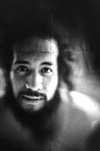 Jorge Panchoaga (Colombia, 1984). Lives and works in Colombia. He teaches the specialization in Photography at the Arts Faculty of the Universidad Nacional de Colombia. As a photographer, his interests focus on socio-cultural issues of identity, memory, language, cultural change following conflict and man’s relationship with the landscape. He graduated in Anthropology from the Universidad de Cauca. He is a photography specialist at the Universidad Nacional de Colombia. He is an X-photographer at Fujifilm Colombia, and belongs to the +1 Photography Collective. His work is available at: www.panchoaga.com
Jorge Panchoaga (Colombia, 1984). Lives and works in Colombia. He teaches the specialization in Photography at the Arts Faculty of the Universidad Nacional de Colombia. As a photographer, his interests focus on socio-cultural issues of identity, memory, language, cultural change following conflict and man’s relationship with the landscape. He graduated in Anthropology from the Universidad de Cauca. He is a photography specialist at the Universidad Nacional de Colombia. He is an X-photographer at Fujifilm Colombia, and belongs to the +1 Photography Collective. His work is available at: www.panchoaga.comJorge Panchoaga presents his book La Casa Grande. Streaming within the Storytelling & New Media Diploma at Fundación Pedro Meyer's Campus Virtual, November 2013
 Jorge Panchoaga (Colombia, 1984). Lives and works in Colombia. He teaches the specialization in Photography at the Arts Faculty of the Universidad Nacional de Colombia. As a photographer, his interests focus on socio-cultural issues of identity, memory, language, cultural change following conflict and man’s relationship with the landscape. He graduated in Anthropology from the Universidad de Cauca. He is a photography specialist at the Universidad Nacional de Colombia. He is an X-photographer at Fujifilm Colombia, and belongs to the +1 Photography Collective. His work is available at: www.panchoaga.com
Jorge Panchoaga (Colombia, 1984). Lives and works in Colombia. He teaches the specialization in Photography at the Arts Faculty of the Universidad Nacional de Colombia. As a photographer, his interests focus on socio-cultural issues of identity, memory, language, cultural change following conflict and man’s relationship with the landscape. He graduated in Anthropology from the Universidad de Cauca. He is a photography specialist at the Universidad Nacional de Colombia. He is an X-photographer at Fujifilm Colombia, and belongs to the +1 Photography Collective. His work is available at: www.panchoaga.comPage 1 of 2
Page 1 of 2





